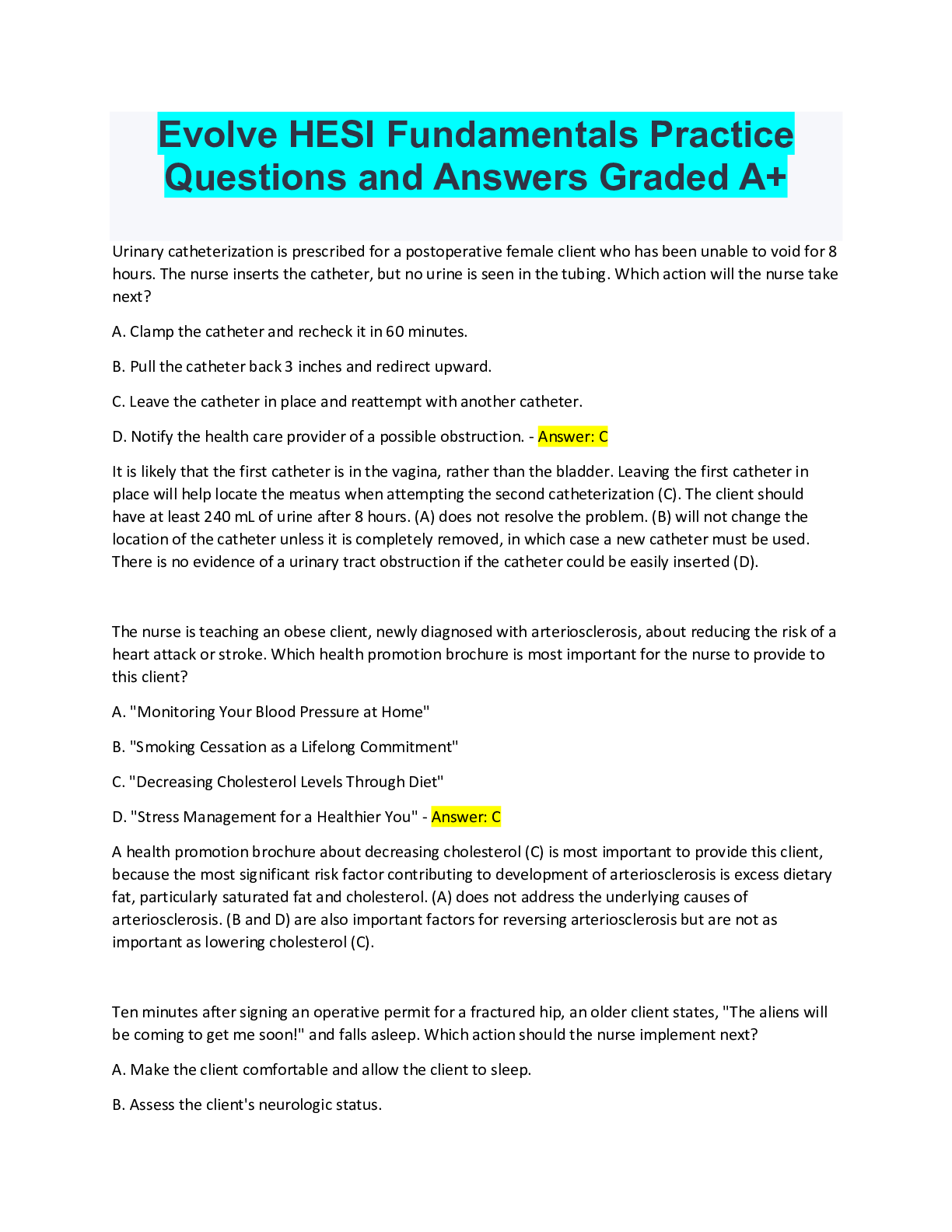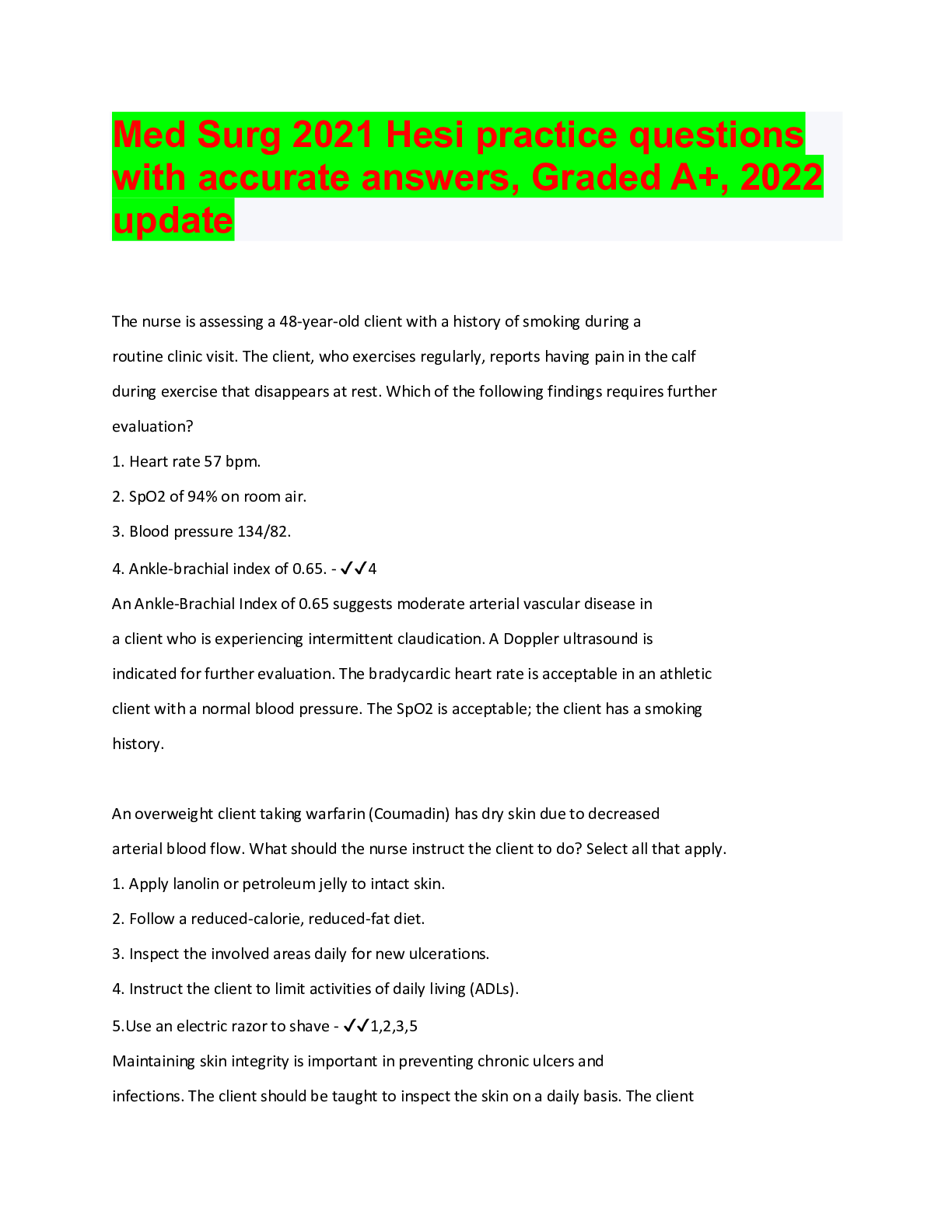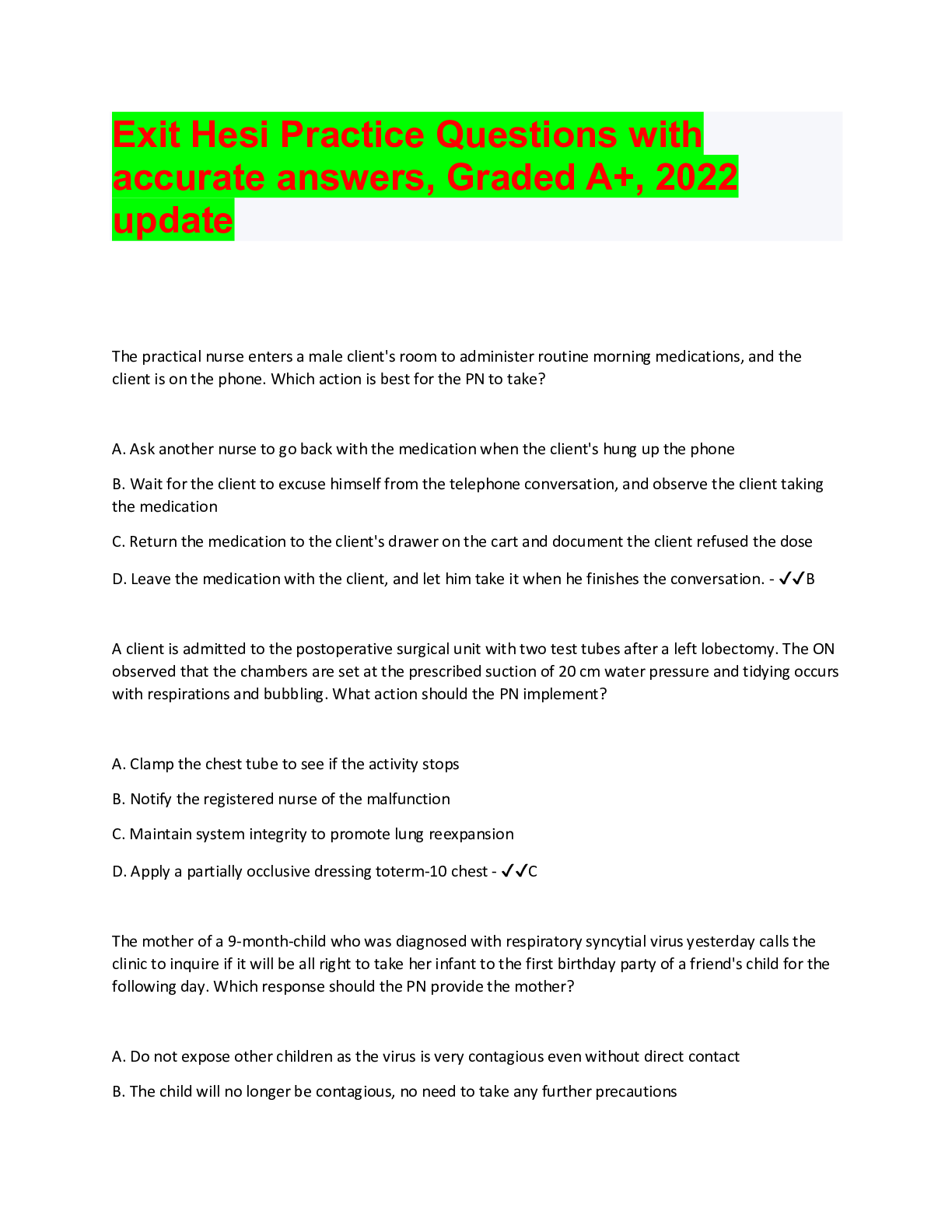HESI - Fundamentals practice questions with accurate answers, rated A
Document Content and Description Below
HESI - Fundamentals practice questions with accurate answers, rated A 1. When turning an immobile bedridden client without assistance, whichaction by the nurse best ensures client safety? A. Secu... rely grasp the client's arm and leg. B. Put bed rails up on the side of bed opposite from the nurse. C. Correctly position and use a turn sheet. D. Lower the head of the client's bed slowly. Rationale: Because the nurse can only stand on one side of the bed, bed rails should be up on the opposite side to ensure that the client does not fall out of bed. Option A can cause client injury to the skin or joint. Options C and D are useful techniques while turning a client but have less priority in terms of safety than use of the bed rails. 2. The nurse identifies a potential for infection in a client with partialthickness (second-degree) and full-thickness (third-degree) burns. What intervention has the highest priority in decreasing the client's risk of infection? A. Administration of plasma expanders B. Use of careful handwashing technique C. Application of a topical antibacterial cream D. Limiting visitors to the client with burns Rationale: Careful handwashing technique is the single most effective intervention for the prevention of contamination to all clients. Option A reverses the hypovolemia that initially accompanies burn trauma but is not related to decreasing the proliferation of infective organisms. Options C and D are recommended by various burn centers as possible ways to reduce the chance of infection. Option B is a proven technique to prevent infection. 3. The nurse is aware that malnutrition is a common problem among clients lOMoARcPSD|499 043 4 served by a community health clinic for the homeless. Which laboratory value is the most reliable indicator of chronic protein malnutrition? lOMoARcPSD|499 043 4 A. Low serum albumin level B. Low serum transferrin level C. High hemoglobin level D. High cholesterol level Rationale: Long-term protein deficiency is required to cause significantly lowered serum albumin levels. Albumin is made by the liver only when adequate amounts of amino acids (from protein breakdown) are available. Albumin has a long half-life, so acute protein loss does not significantly alter serum levels. Option B is a serum protein with a half-life of only 8 to 10 days, so it will drop with an acute protein deficiency. Options C and D are not clinical measures of protein malnutrition. 4. In completing a client's preoperative routine, the nurse finds that the operative permit is not signed. The client begins to ask more questions about the surgical procedure. Which action should the nurse take next? A. Witness the client's signature to the permit. B. Answer the client's questions about the surgery. C. Inform the surgeon that the operative permit is not signed and the client has questions about the surgery. D. Reassure the client that the surgeon will answer any questions before the anesthesia is administered. Rationale: The surgeon should be informed immediately that the permit is not signed. It is the surgeon's responsibility to explain the procedure to the client and obtain the client's signature on the permit. Although the nurse can witness an operative permit, the procedure must first be explained by the health care provider or surgeon, including answering the client's questions. The client's questions should be addressed before the permit is signed. 5. The nurse is assessing several clients prior to surgery. Which factor in a client's history poses the greatest threat for complications to occur during surgery? A. Taking birth control pills for the past 2 years B. Taking anticoagulants for the past year C. Recently completing antibiotic therapy D. Having taken laxatives PRN for the last 6 months lOMoARcPSD|499 043 4 Rationale: Anticoagulants increase the risk for bleeding during surgery, which can pose a threat for the development of surgical complications. The health care provider should be informed that the client is taking these drugs. Although clients who take birth control pills may be more susceptible to the development of thrombi, such problems usually occur postoperatively. A client with option C or D is at less of a surgical risk than with option B. 6. When assisting a client from the bed to a chair, which procedure is best for the nurse to follow? A. Place the chair parallel to the bed, with its back toward the head of the bed and assist the client in moving to the chair. B. With the nurse's feet spread apart and knees aligned with the client's knees, stand and pivot the client into the chair. C. Assist the client to a standing position by gently lifting upward, underneath the axillae. D. Stand beside the client, place the client's arms around the nurse's neck, and gently move the client to the chair. Rationale: Option B describes the correct positioning of the nurse and affords the nurse a wide base of support while stabilizing the client's knees when assisting to a standing position. The chair should be placed at a 45-degree angle to the bed, with the back of the chair toward the head of the bed. Clients should never be lifted under the axillae; this could damage nerves and strain the nurse's back. The client should be instructed to use the arms of the chair and should never place his or her arms around the nurse's neck; this places undue stress on the nurse's neck and back and increases the risk for a fall. 7.Which step(s) should the nurse take when administering ear drops to an adult client? (Select all that apply.) A. Place the client in a side-lying position. B. Pull the auricle upward and outward. C. Hold the dropper 6 cm above the ear canal. D. Place a cotton ball into the inner canal. E. Pull the auricle down and back. Rationale: lOMoARcPSD|499 043 4 The correct answers (A and B) are the appropriate administration of ear drops. The dropper should be held 1 cm (½ inch) above the ear canal (C). A cotton ball should be placed in the outermost canal (D). The auricle is pulled down and back for a child younger than 3 years of age, but not an adult (E). 8.The nurse is instructing a client in the proper use of a metered-dose inhaler. Which instruction should the nurse provide the client to ensure the optimal benefits from the drug? A. "Fill your lungs with air through your mouth and then compress the inhaler." B. "Compress the inhaler while slowly breathing in through your mouth." C. "Compress the inhaler while inhaling quickly through your nose." D. "Exhale completely after compressing the inhaler and then inhale." Rationale: The medication should be inhaled through the mouth simultaneously with compression of the inhaler. This will facilitate the desired destination of the aerosol medication deep in the lungs for an optimal bronchodilation effect. Options A, C, and D do not allow for deep lung penetration 9. A 20-year-old female client with a noticeable body odor has refused to shower for the last 3 days. She states, "I have been told that it is harmful to bathe during my period." Which action should the nurse take first? A. Accept and document the client's wish to refrain from bathing. B. Offer to give the client a bed bath, avoiding the perineal area. C. Obtain written brochures about menstruation to give to the client. D. Teach the importance of personal hygiene during menstruation with the client. Rationale: Because a shower is most beneficial for the client in terms of hygiene, the client should receive teaching first, respecting any personal beliefs such as cultural or spiritual values. After client teaching, the client may still choose option A or B. Brochures reinforce the teaching. lOMoARcPSD|499 043 4 10. While reviewing the side effects of a newly prescribed medication, a 72-yearold client notes that one of the side effects is a reduction in sexual drive. Which is the best response by the nurse? A. "How will this affect your present sexual activity?" B. "How active is your current sex life?" C. "How has your sex life changed as you have become older?" D. "Tell me about your sexual needs as an older adult." Rationale: Option A offers an open-ended question most relevant to the client's statement. Option B does not offer the client the opportunity to express concerns. Options C and D are even less relevant to the client's statement. 11.The nurse is using the Glasgow Coma Scale to perform a neurologic assessment. A comatose client winces and pulls away from a painful stimulus. Which action should the nurse take next? A. Document that the client responds to painful stimulus. B. Observe the client's response to verbal stimulation. C. Place the client on seizure precautions for 24 hours. D. Report decorticate posturing to the health care provider. Rationale: The client has demonstrated a purposeful response to pain, which should be documented as such. Response to painful stimulus is assessed after response to verbal stimulus, not before. There is no indication for placing the client on seizure precautions. Reporting decorticate posturing to the health care provider is nonpurposeful movement. 12. The nurse plans to administer diazepam, 4 mg IV push, to a client with severe anxiety. How many milliliters should the nurse administer? (Round to the nearest tenth.) lOMoARcPSD|499 043 4 A. 0.2 mL B. 0.8 mL C. 1.25 mL D. 2.0 mL Rationale: (1 mL × 4 mg)/5 mg = 0.8 mL 13. The nurse prepares to insert a nasogastric tube in a client with hyperemesis who is awake and alert. Which intervention(s) is(are) correct? (Select all that apply.) A. Place the client in a high Fowler position. B. Help the client assume a left side-lying position. C. Measure the tube from the tip of the nose to the umbilicus. D. Instruct the client to swallow after the tube has passed the pharynx. E. Assist the client in extending the neck back so the tube may enter the larynx. Rationale: (A and D) are the correct steps to follow during nasogastric intubation. Only the unconscious or obtunded client should be placed in a left side-lying position (B). The tube should be measured from the tip of the nose to behind the ear and then from behind the ear to the xiphoid process (C). The neck should only be extended back prior to the tube passing the pharynx and then the client should be instructed to position the neck forward (E). 14. The nurse teaches the use of a gait belt to a male caregiver whose wife has right-sided weakness and needs assistance with ambulation. The caregiver performs a return demonstration of the skill. Which observation indicates that the caregiver has learned how to perform this procedure correctly? A. Standing on his wife's strong side, the caregiver is ready to hold the gait belt if any evidence of weakness is observed. B. Standing on his wife's weak side, the caregiver lOMoARcPSD|499 043 4 provides security by holding the gait belt from the back. C. Standing behind his wife, the caregiver provides balance by holding both sides of the gait belt. D. Standing slightly in front and to the right of his wife, the caregiver guides her forward by gently pulling on the gait belt. Rationale: His wife is most likely to lean toward the weak side and needs extra support on that side and from the back to prevent falling. Options A, C, and D provide less security for her. 15. Which nursing diagnosis has the highest priority when planning care for a client with an indwelling urinary catheter?. A. Self-care deficit B. Functional incontinence C. Fluid volume deficit D. High risk for infection Rationale: Indwelling urinary catheters are a major source of infection. Options A and B are both problems that may require an indwelling catheter. Option C is not affected by an indwelling catheter 16. A client has a nursing diagnosis of Altered sleep patterns related to nocturia. Which client instruction is important for the nurse to provide? A. Decrease intake of fluids after the evening meal. B. Drink a glass of cranberry juice every day. C. Drink a glass of warm decaffeinated beverage at bedtime. D. Consult the health care provider about a sleeping pill. Rationale: Nocturia is urination during the night. Option A is helpful to decrease the production of urine, thus decreasing the need to void at night. Option B helps prevent bladder infections. Option C may promote sleep, but the fluid will contribute to nocturia. Option D may result in urinary incontinence if the client is sedated and does not awaken to void. 17. When performing sterile wound care in the acute care setting, the nurse obtains a bottle of normal saline from the bedside table that is labeled "opened" and dated 48 hours prior to the current date. Which is the best action for the nurse lOMoARcPSD|499 043 4 to take? A. Use the normal saline solution once more and then discard. B. Obtain a new sterile syringe to draw up the labeled saline solution. C. Use the saline solution and then relabel the bottle with the current date. D. Discard the saline solution and obtain a new unopened bottle. Rationale: Solutions labeled as opened within 24 hours may be used for clean procedures, but only newly opened solutions are considered sterile. This solution is not newly opened and is out of date, so it should be discarded. Options A, B, and C describe incorrect procedures. 18. Based on the nursing diagnosis of risk for infection, which intervention is best for the nurse to implement when providing care for an older incontinent client? A. Maintain standard precautions. B. Initiate contact isolation measures. C. Insert an indwelling urinary catheter. D. Instruct client in the use of adult diapers. Rationale: The best action to decrease the risk of infection in vulnerable clients is handwashing. Option B is not necessary unless the client has an infection. Option C increases the risk of infection. Option D does not reduce the risk of infection. 19. When taking a client's blood pressure, the nurse is unable to distinguish the point at which the first sound was heard. Which is the best action for the nurse to take? A. Deflate the cuff completely and immediately reattempt the reading. B. Reinflate the cuff completely and leave it inflated for 90 to 110 seconds before taking the second reading. C. Deflate the cuff to zero and wait 30 to 60 seconds before reattempting the reading. D. Document the exact level visualized on the sphygmomanometer where the first fluctuation was seen. lOMoARcPSD|499 043 4 Rationale: Deflating the cuff for 30 to 60 seconds allows blood flow to return to the extremity so that an accurate reading can be obtained on that extremity a second time. Option A could result in a falsely high reading. Option B reduces circulation, causes pain, and could alter the reading. Option D is not an accurate method of assessing blood pressure. 20.A client's blood pressure reading is 156/94 mm Hg. Which action should the nurse take first? A. Tell the client that the blood pressure is high and that the reading needs to be verified by another nurse. B. Contact the health care provider to report the reading and obtain a prescription for an antihypertensive medication. C. Replace the cuff with a larger one to ensure an ample fit for the client to increase arm comfort. D. Compare the current reading with the client's previously documented blood pressure readings. Rationale: Comparing this reading with previous readings will provide information about what is normal for this client; this action should be taken first. Option A might unnecessarily alarm the client. Option B is premature. Further assessment is needed to determine if the reading is abnormal for this client. Option C could falsely decrease the reading and is not the correct procedure for obtaining a blood pressure reading. 21.A nurse stops at a motor vehicle collision site to render aid until the emergency personnel arrive and applies pressure to a groin wound that is bleeding profusely. Later the client has to have the leg amputated and sues the nurse for malpractice. Which is the most likely outcome of this lawsuit? A. The Patient's Bill of Rights protects clients from malicious intents, so the nurse could lose the case. B. The lawsuit may be settled out of court, but the nurse's license is likely to be revoked. C. There will be no judgment against the nurse, whose actions were protected under the Good Samaritan Act. lOMoARcPSD|499 043 4 D. The client will win because the four elements of negligence (duty, breach, causation, and damages) can be proved. Rationale: The Good Samaritan Act protects health care professionals who practice in good faith and provide reasonable care from malpractice claims, regardless of the client outcome. Although the Patient's Bill of Rights protects clients, this nurse is protected by the Good Samaritan Act. The state Board of Nursing has no reason to revoke a registered nurse's license unless there was evidence that actions taken in the emergency were not done in good faith or that reasonable care was not provided. All four elements of malpractice were not shown. 22. When the health care provider diagnoses metastatic cancer and recommends a gastrostomy for an older female client in stable condition, the son tells the nurse that his mother must not be told the reason for the surgery because she "can't handle" the cancer diagnosis. Which legal principle is the court most likely to uphold regarding this client's right to informed consent? A. The family can provide the consent required in this situation because the older adult is in no condition to make such decisions. B. Because the client is mentally incompetent, the son has the right to waive informed consent for her. C. The court will allow the health care provider to make the decision to withhold informed consent under therapeutic privilege. D. If informed consent is withheld from a client, health care providers could be found guilty of negligence. Rationale: Health care providers may be found guilty of negligence, specifically assault and battery, if they carry out a treatment without the client's consent. The client's condition is stable, so option A is not a valid rationale. Advanced age does not automatically authorize the son to make all decisions for his mother, and there is no evidence that the client is mentally incompetent. Although option C may have been upheld in the past, when paternalistic medical practice was common, today's courts are unlikely to accept it 23.The nurse is obtaining a lie-sit-stand blood pressure reading on a client. Which action is most important for the nurse to implement? A. Stay with the client while the client is standing. B. Record the findings on the graphic sheet in the lOMoARcPSD|499 043 4 chart. C. Keep the blood pressure cuff on the same arm. D. Record changes in the client's pulse rate. Rationale: Although all these measures are important, option A is most important because it helps ensure client safety. Option B is necessary but does not have the priority of option A. Options C and D are important measures to ensure accuracy of the recording but are of less importance than providing client safety. 24. A client becomes angry while waiting for a supervised break to smoke a cigarette outside and states, "I want to go outside now and smoke. It takes forever to get anything done here!" Which intervention is best for the nurse to implement? A. Encourage the client to use a nicotine patch. B. Reassure the client that it is almost time for another break. C. Have the client leave the unit with another staff member. D. Review the schedule of outdoor breaks with the client. Rationale: The best nursing action is to review the schedule of outdoor breaks and provide concrete information about the schedule. Option A is contraindicated if the client wants to continue smoking. Option B is insufficient to encourage a trusting relationship with the client. Option C is preferential for this client only and is inconsistent with unit rules. 25. Which serum laboratory value should the nurse monitor carefully for a client who has a nasogastric (NG) tube to suction for the past week? A. White blood cell count B. Albumin C. Calcium D. Sodium Rationale: Monitoring serum sodium levels for hyponatremia is indicated during prolonged NG suctioning because of loss of fluids. Changes in levels of option A, B, or C are not typically associated with prolonged NG suctioning. 26. A female client with frequent urinary tract infections (UTIs) asks the nurse to explain her friend's advice about drinking a glass of juice daily to prevent future UTIs. Which response is best for the nurse to provide? lOMoARcPSD|499 043 4 A. Orange juice has vitamin C that deters bacterial growth. B. Apple juice is the most useful in acidifying the [Show More]
Last updated: 1 year ago
Preview 1 out of 33 pages
.png)
Also available in bundle (1)
.png)
HESI FUNDAMENTAL BUNDLE, ALL Questions with accurate answers.
All you need for easy revision for HESI EXAMS, 100% Mastery.
By bundleHub Solution guider 1 year ago
$28
13
Reviews( 0 )
Document information
Connected school, study & course
About the document
Uploaded On
Oct 03, 2022
Number of pages
33
Written in
Additional information
This document has been written for:
Uploaded
Oct 03, 2022
Downloads
0
Views
92

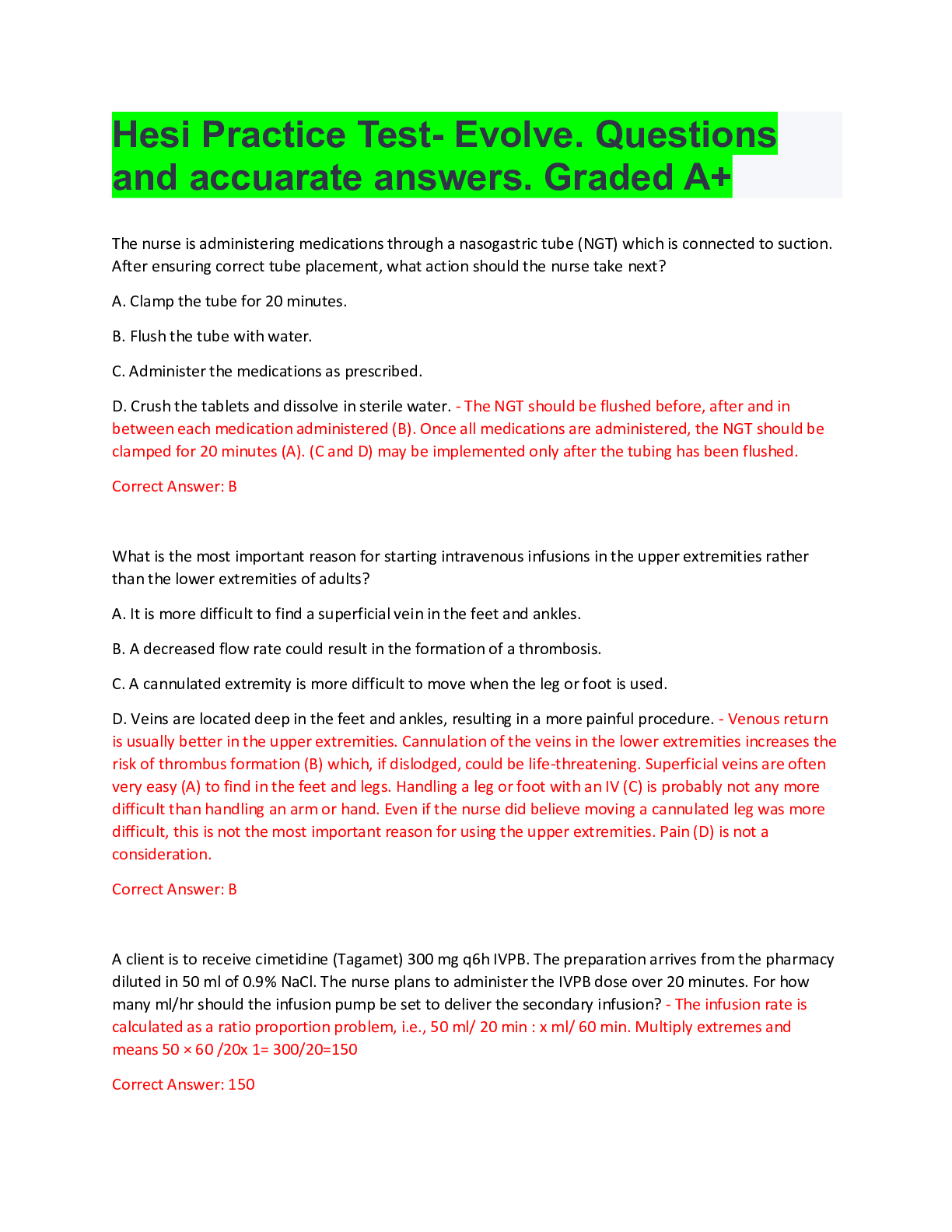
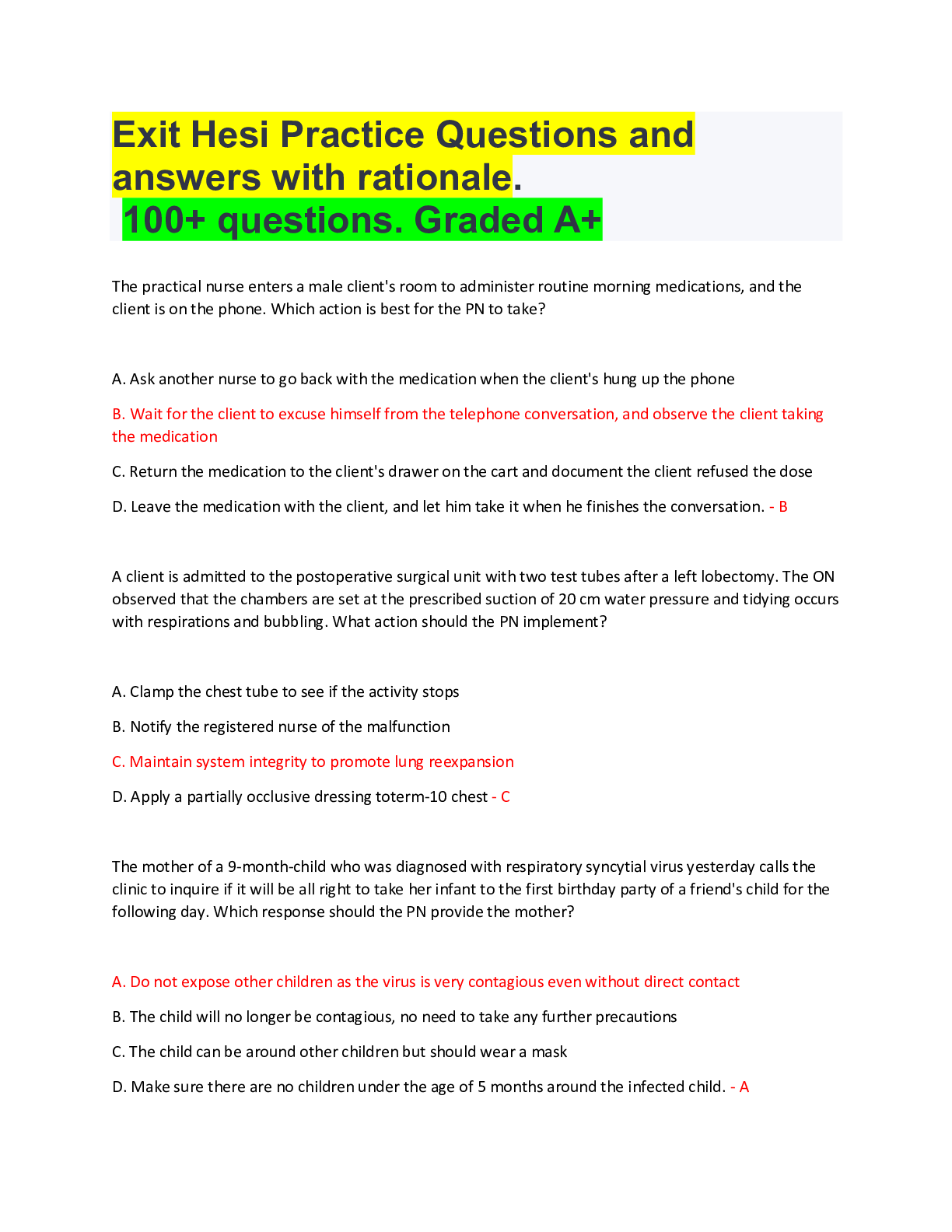

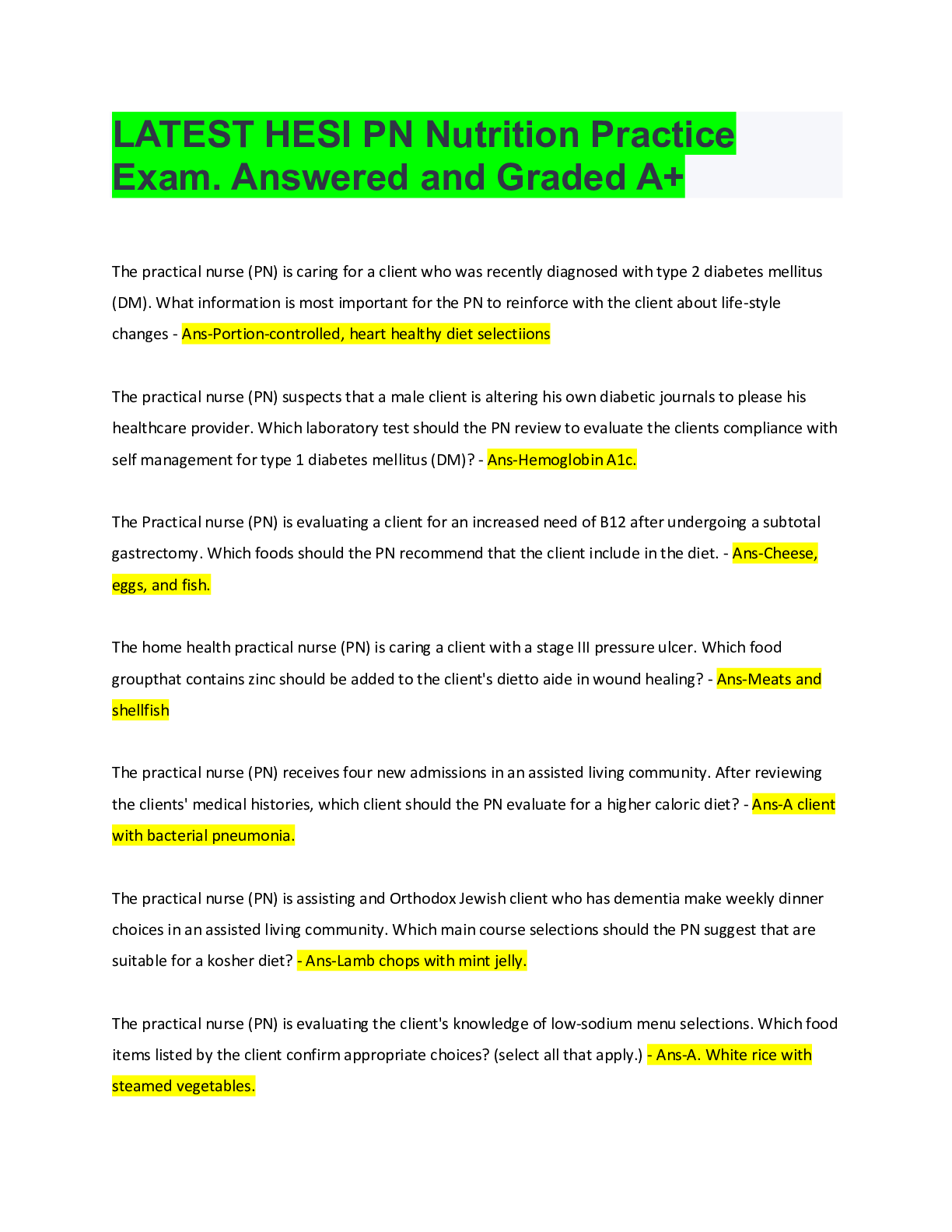


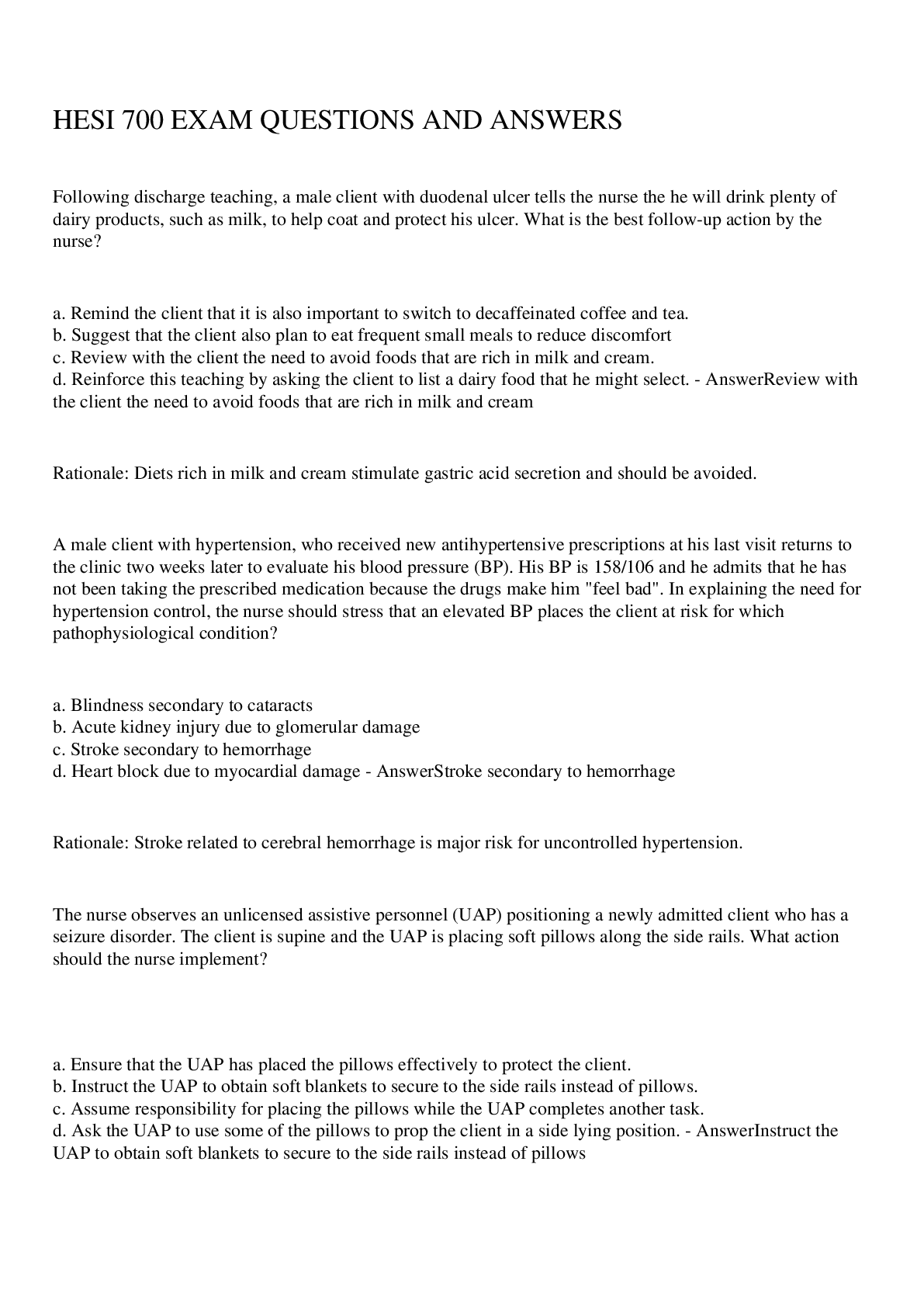


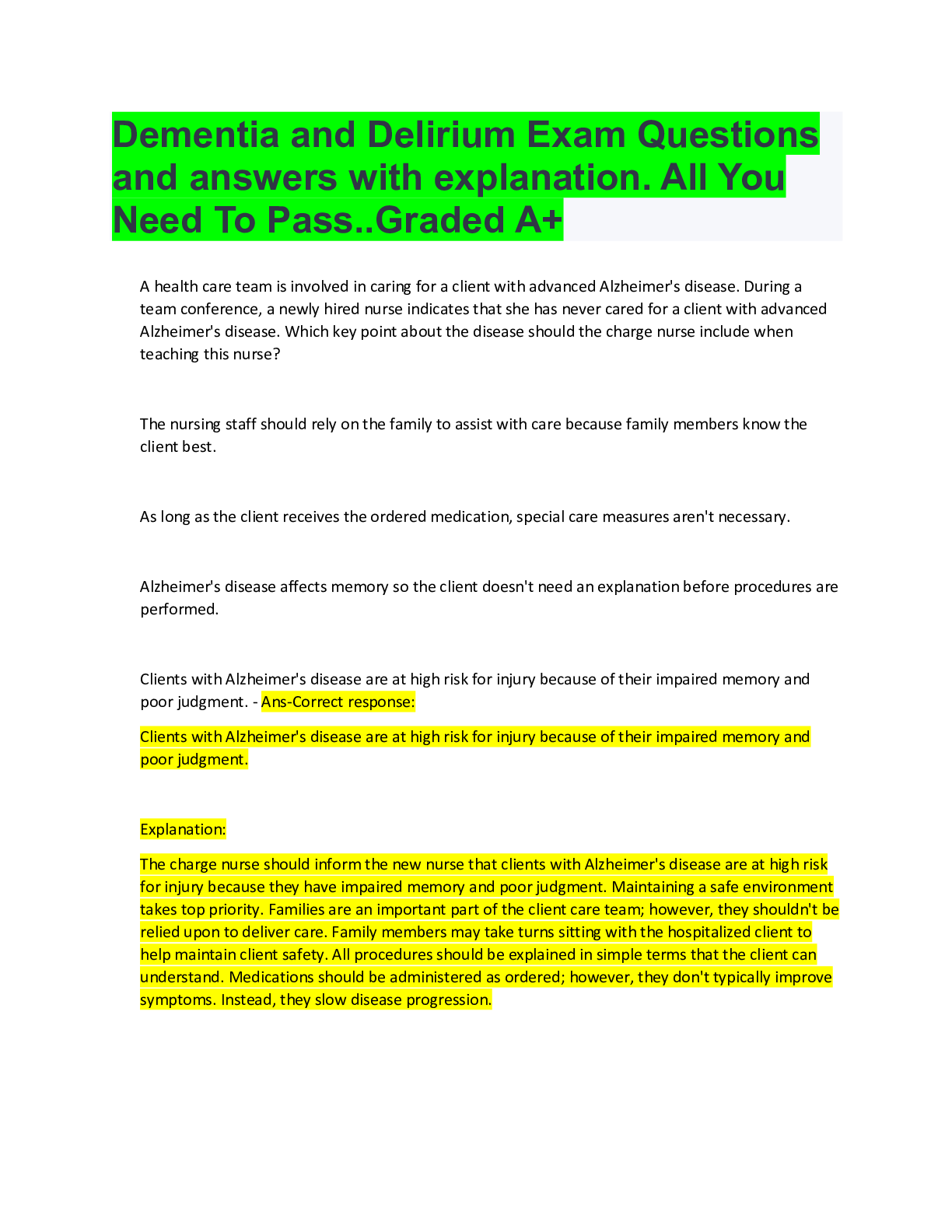


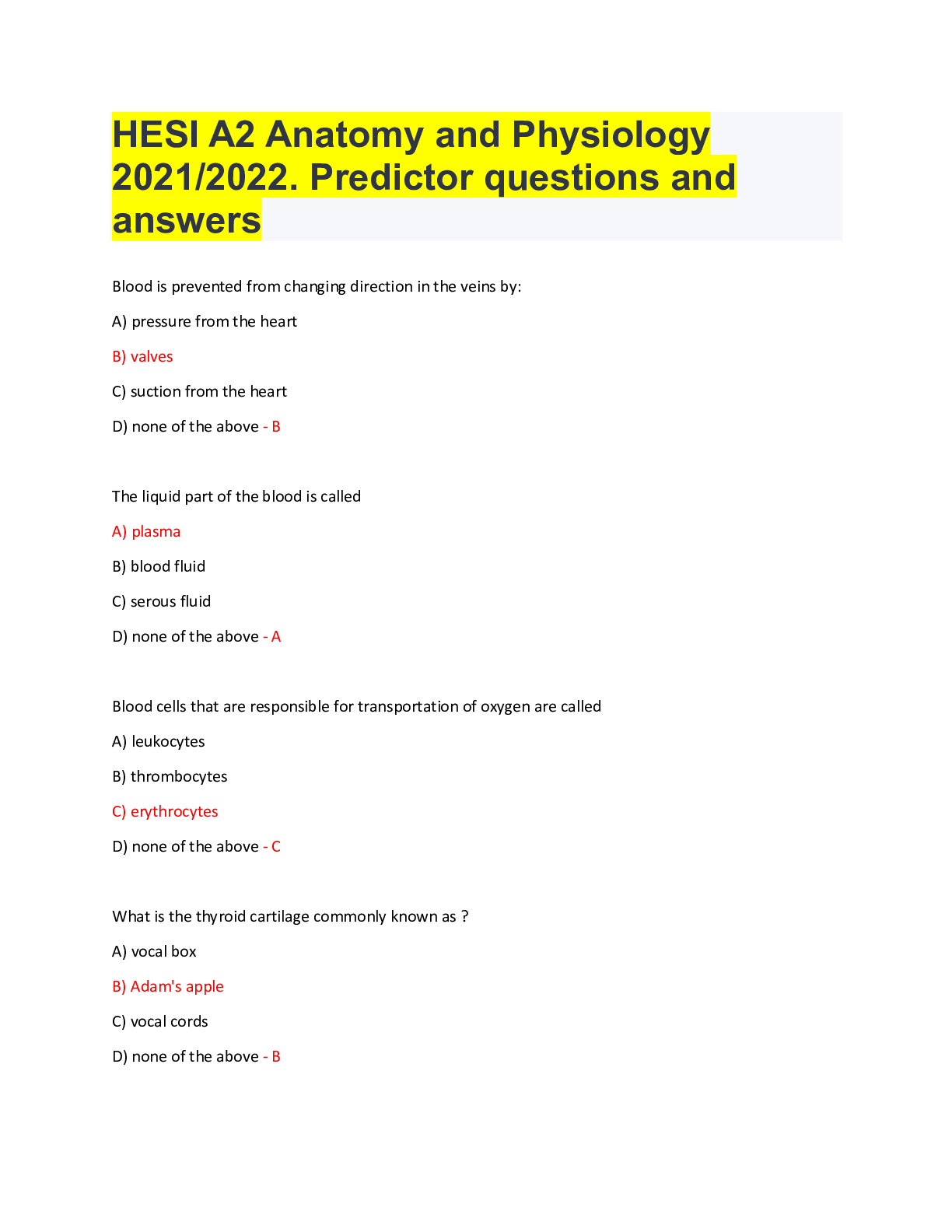

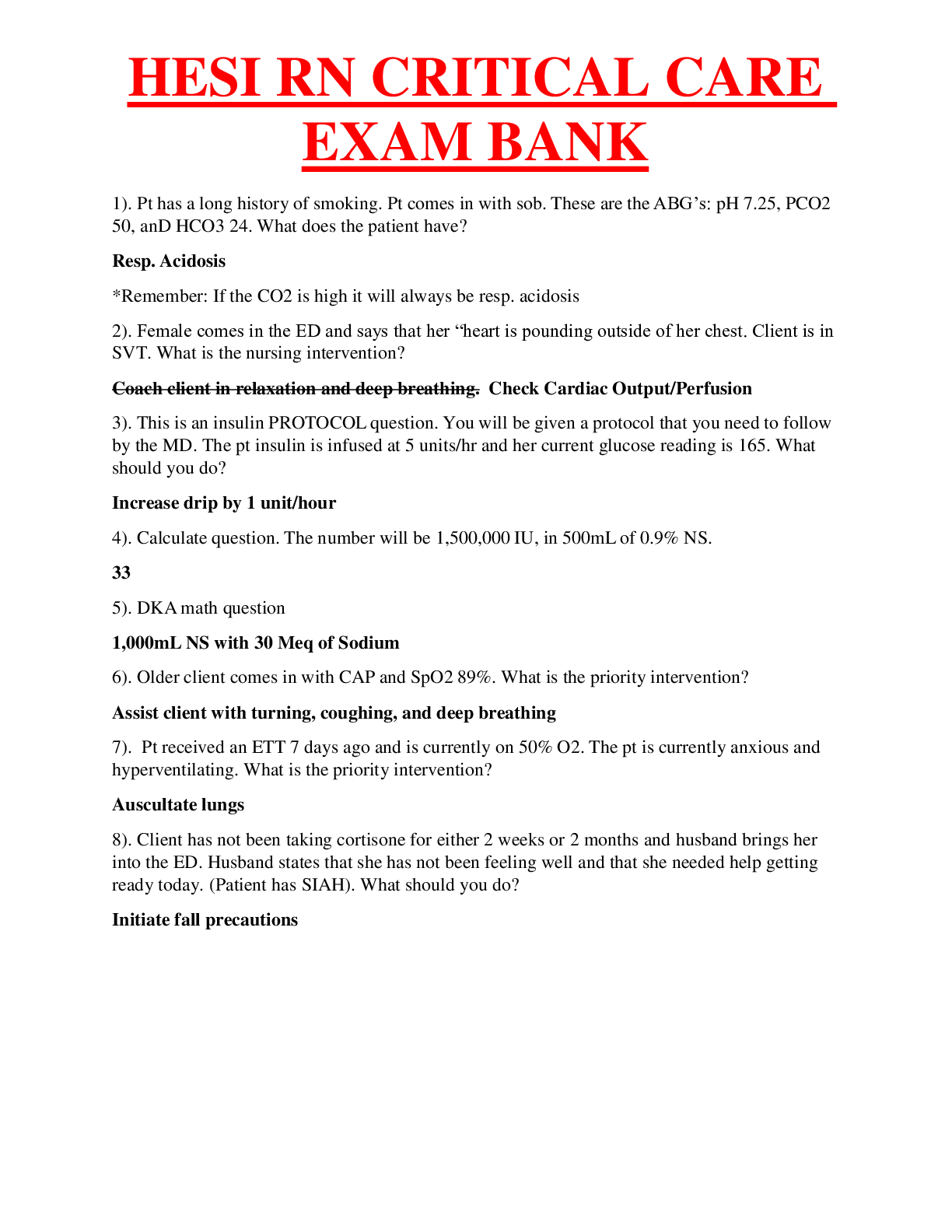
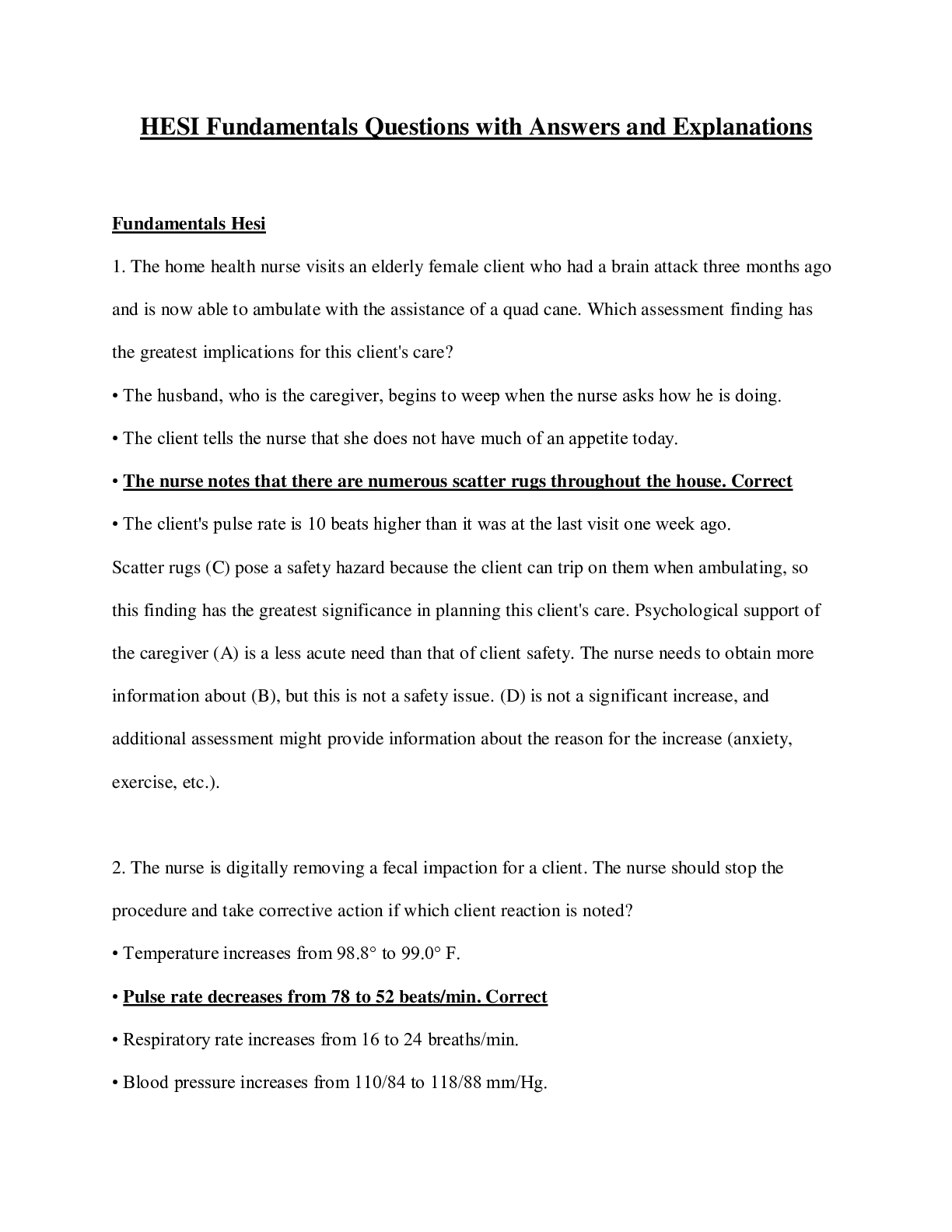
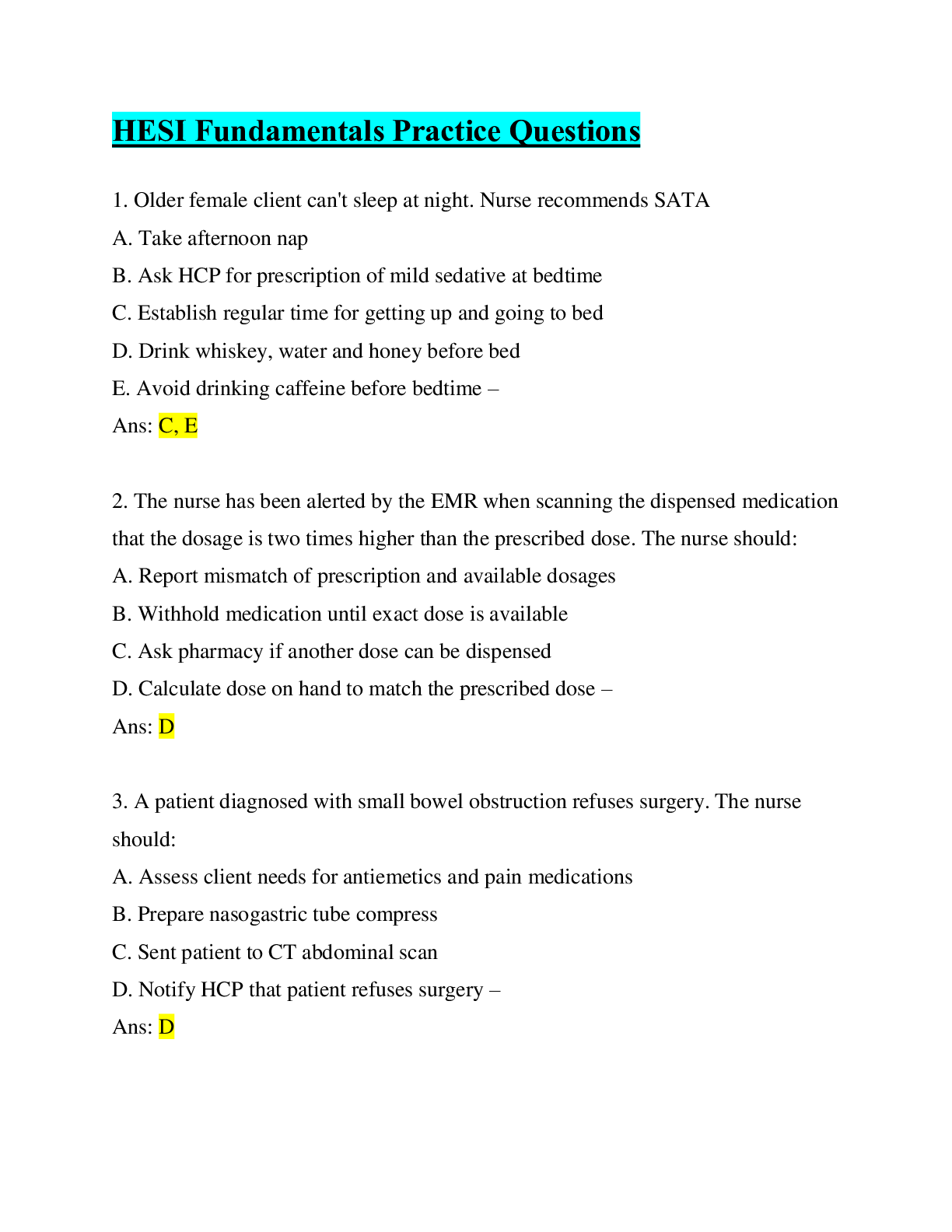


.png)
.png)


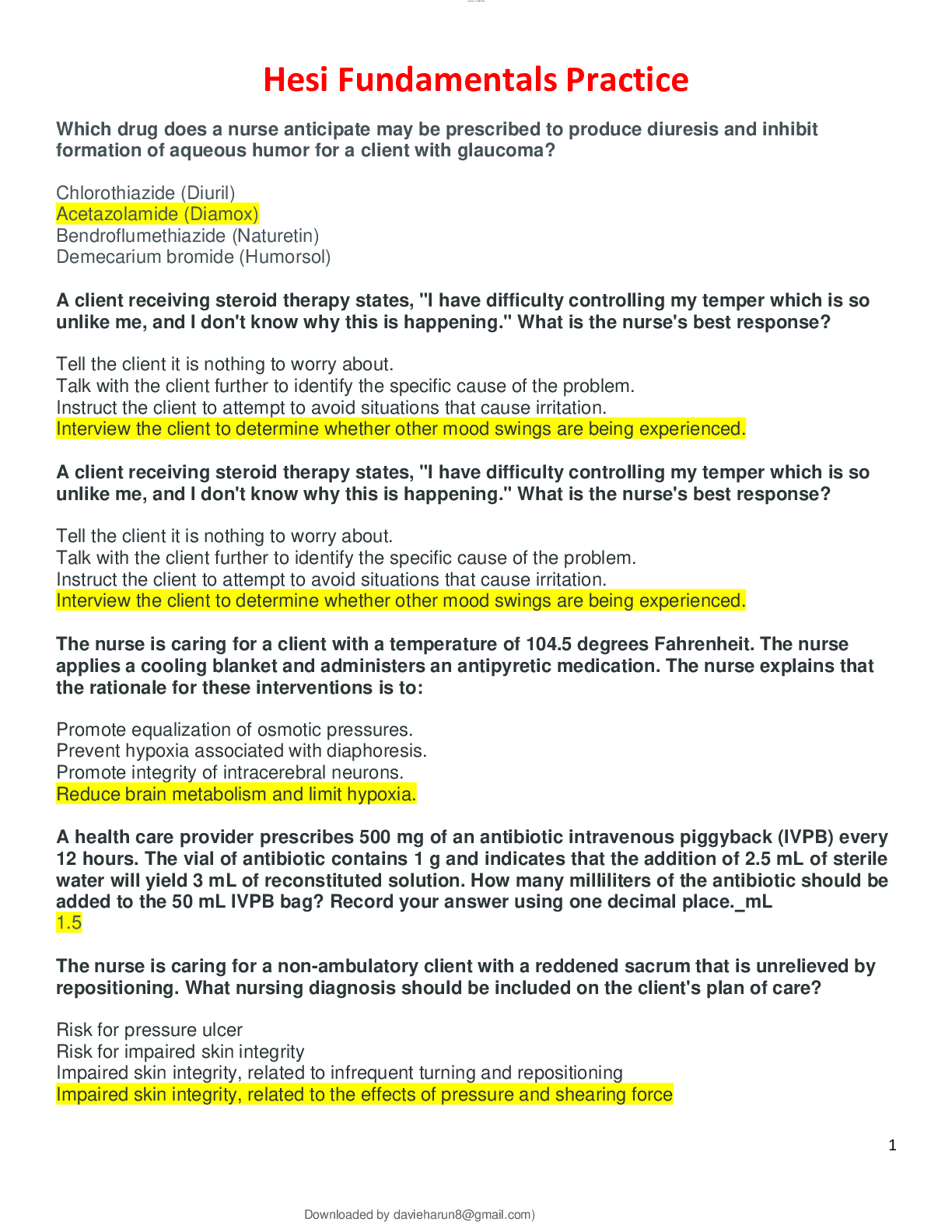
.png)
.png)
